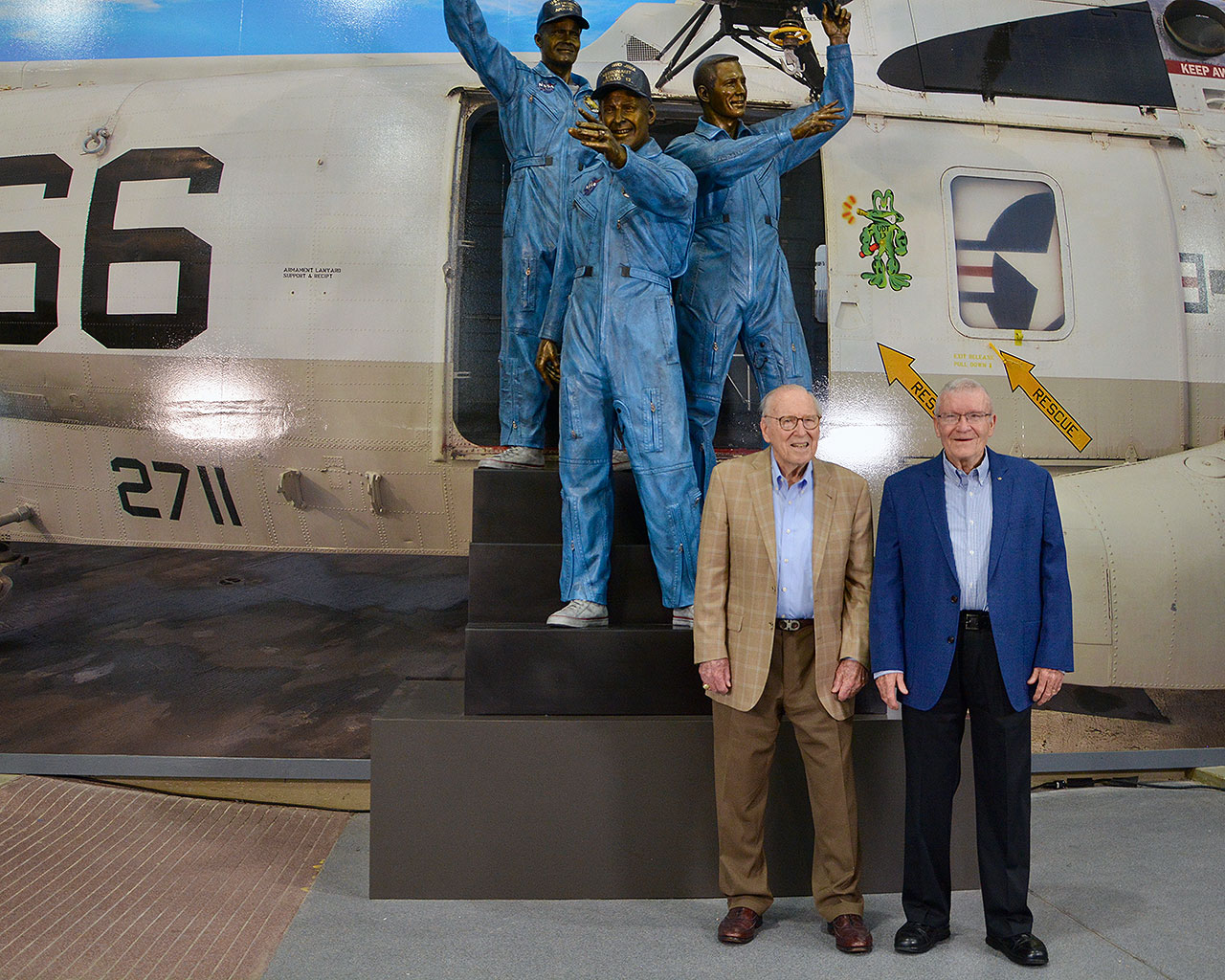Apollo 13 astronauts raise a toast to their recovery with new statue

Fifty-one years to the day after they survived an explosion on the way to the moon, astronauts Jim Lovell and Fred Haise came face-to-face with their post-splashdown selves in Houston.
The two Apollo 13 crewmates celebrated the 51st anniversary of their safe return to Earth by toasting the installation of a life-size sculpture capturing the moment they stepped off a Navy helicopter onto an aircraft carrier, marking their successful recovery on April 17, 1970. The painted bronze statue first debuted at Space Center Houston in February, but Saturday (April 17) marked its formal dedication.
Looking up at their sculpted selves, Lovell and Haise reflected on the day when their ill-fated moon landing mission came to an end.
"I think the greatest feeling was when we hit the water and water splashed over the window, and I looked at Fred and said, 'Hey, I think we made it,'" Lovell said with a laugh, recalling their splashdown aboard the Apollo 13 command module "Odyssey."
"Specifically to me, that day was nice to be in a South Pacific environment," said Haise. "When the diver opened the hatch, it was amazing that the capsule, after all of that, through the re-entry, was still cold. Frosty air poured out of the capsule when they opened the hatch."

"I was not feeling very well, despite my smiling face," Haise recalled, referencing the happy expression on his statue. "I had a urinary tract infection. I had chills and a fever. And I missed the big party on the ship. They had a cake and ice cream with the crew on the hangar deck and I went to sick bay. I was happy to have that successful landing after a lot of challenges to getting us back."
The splashdown concluded the six-day Apollo 13 mission, which famously "had a problem." An oxygen tank in the spacecraft's service module exploded, changing the mission from one of landing on the moon to getting commander Lovell, lunar module pilot Haise and command module pilot Jack Swigert safely home. (Swigert died of cancer in 1982 at age 51.)
Breaking space news, the latest updates on rocket launches, skywatching events and more!
That job fell to the teams of flight controllers in Mission Control at NASA's Manned Spacecraft Center (today Johnson Space Center) in Houston.
"In some aspects, it was a better ending with regards to what we learned and the ability of NASA to complete or save missions," said Lovell. "And that's what that statue stands for. If people look at that statue, it is really the recovery of Apollo 13 by a group of people on the ship and in Mission Control."

Joining Lovell and Haise at Space Center Houston for the anniversary were three of the four flight directors who led Mission Control during Apollo 13: Milt Windler, Gerry Griffin and Gene Kranz. (The fourth, Glynn Lunney, died a month earlier on March 19.)
"We never thought about not getting them back. In fact, we never discussed it. We were going to get them back," said Griffin. "So when we finally got them back down on the [aircraft] carrier, that's when you saw a lot of celebration going on and a bunch of tired guys."
For Kranz, all of the lessons that were learned through flying the Mercury and Gemini missions, as well as the early Apollo flights, led up to what they were faced 51 years ago.
"Thirteen was really where it came together," Kranz said. "We knew we were a team that was very capable of stepping up to managing and responding to any crisis we might find ourselves in. It was a marvelous example of the teamwork between the support teams and Mission Control to find the solutions to bring them home."

The statue was created by Colorado-based sculptors and brothers George and Mark Lundeen, working with fellow artist Joey Bainer. Funded by The Grainger Foundation of Lake Forest, Illinois, the project was presented to Space Center Houston by documentary filmmaker Steven Barber. The photo-realistic mural of the Sea King helicopter was created by Houston graphic designer Blake Dumesnil for Space Center Houston.
"I think it's a great replica," said Haise of the display. "I am not the artist-type, so it is amazing to me that they can do it that well, even including the helicopter and the platform we walked off of. That was very well done."
Lovell agreed that the statue was "really fantastic."
"It has a story for the future people coming in here, especially the astronauts we do not know yet, those who will come in the years ahead," he said. "I think it tells the story of the cooperation between the various aspects of NASA and the space industry to do the missions they were designed to do and how they work together to complete them."
Follow collectSPACE.com on Facebook and o

Robert Pearlman is a space historian, journalist and the founder and editor of collectSPACE.com, a daily news publication and community devoted to space history with a particular focus on how and where space exploration intersects with pop culture. Pearlman is also a contributing writer for Space.com and co-author of "Space Stations: The Art, Science, and Reality of Working in Space” published by Smithsonian Books in 2018.
In 2009, he was inducted into the U.S. Space Camp Hall of Fame in Huntsville, Alabama. In 2021, he was honored by the American Astronautical Society with the Ordway Award for Sustained Excellence in Spaceflight History. In 2023, the National Space Club Florida Committee recognized Pearlman with the Kolcum News and Communications Award for excellence in telling the space story along the Space Coast and throughout the world.

